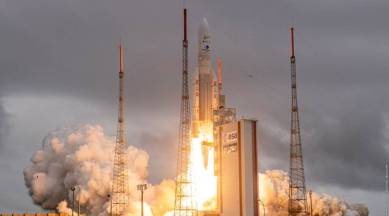James Webb Space Telescope Launch Highlights December 25: The liftoff scheduled for December 22 was postponed to December 24 due to difficulties in electronic communications between the launch vehicle and its payload. It was further delayed until Christmas Day due to poor weather conditions at the launch site.
James Webb Space Telescope Launch Highlights: Successful liftoff from French Guiana
🔴James Webb Space Telescope Launch Highlights Updates December 25: It carries four main scientific instruments and will “hunt for the unobserved formation of the first galaxies, as well as to look inside dust clouds where stars and planetary systems are forming today,” according to NASA.

James Webb Space Telescope Launch Highlights: NASA’s James Webb Space Telescope (JWST) was launched at 5:50 pm IST on December 25. Webb, NASA’s largest space science telescope ever constructed, will be the successor of the Hubble Space Telescope, that has been in service for more than three decades now.
Read More
Carrying four main scientific instruments, Near-Infrared Camera, Near-Infrared Spectrograph, Mid-Infrared Instrument, and Near-Infrared Imager and Slitless Spectrograph, Webb will “hunt for the unobserved formation of the first galaxies, as well as to look inside dust clouds where stars and planetary systems are forming today,” according to NASA.
JWST has the ability to look in the infrared spectrum, which will allow it to peer through much deeper into the universe, and see through obstructions such as gas clouds.
NASA says Webb is not Hubble’s replacement but its successor, whose science goals were motivated by the results from Hubble. Webb will primarily study the universe in the infrared, while Hubble looks at it mainly at optical and ultraviolet wavelengths. Webb’s mirror is much larger than Hubble’s; it can, therefore, look farther back into time than Hubble. Also, Hubble is in a much closer orbit around Earth than Webb will be. Read less
The James Webb Space Telescope has separated. The solar panels are deployed and Webb is now flying on its own power.
If all goes as planned, the 14,000-pound instrument will be released from the French-built rocket after a 26-minute ride into space and gradually unfurl to nearly the size of a tennis court over the next 13 days as it sails onward.
Coasting through space for two more weeks, the Webb telescope will reach its destination in solar orbit 1 million miles from Earth - about four times farther away than the moon. And Webb's special orbital path will keep it in constant alignment with Earth as the planet and telescope circle the sun in tandem. - Reuters
The James Webb Space Telescope is less than 10 minutes from launch for liftoff. NASA spokesperson said that the launch site reports show that all systems are green for launch at 7:20 a.m. EST (5:50 pm IST) ignition.The system is now cut off from external power and is being powered internally by its batteries.
The primary mirror is made of 18 hexagonal-shaped mirror segments — each 1.32 metre in diameter — stitched together in a honeycomb pattern. When fully open it will be 6.5 metre in diameter. The Hubble Space Telescope’s mirror had a diameter of just 2.4 metre.
“The primary mirror is a technological marvel. The lightweight mirrors, coatings, actuators and mechanisms, electronics, and thermal blankets when fully deployed form a single precise mirror that is truly remarkable,” said Lee Feinberg, optical telescope element manager for Webb at NASA’s Goddard Space Flight Center in Greenbelt, Maryland, said in a release.
Read more here
Arianespace tweeted that the fueling process for the Ariane 5 rocket is now complete. The process began at around 1:30 pm IST and was completed at 4:30 pm.
'Webb will be observing some of these extremely hot systems and those with very non-circular orbits and provide new insights into: What does it mean to be extreme? What is happening in that atmosphere? Do they have weather patterns and clouds? And we can relate that back to our own solar system,' says Dr. Knicole Colón, James Webb Space Telescope Deputy Project Scientist for Exoplanet Science.
'With every telescope, we are launching and every study we’re doing — at least my intention — is to get closer to searching for planets and studying planets that are potentially like Earth – maybe the same size or the same temperature.
And Webb will certainly look at some of these Earth-like planets. But it is really hard to look for signs of life. I don’t expect it will actually find signs of life because it is going to require a lot of data. Even if we could find some evidence, it’ll be a long time before we confirm.'
Read the full interview here
In an interview with indianexpress.com, Anisa Jamil, Electrical Power Systems Engineer – NASA Goddard Space Flight Center, explains how NASA’s largest telescope is powered.
Read more here